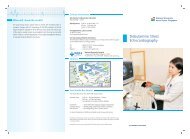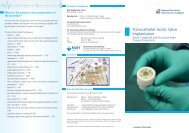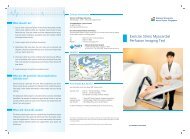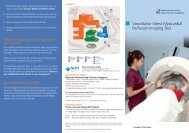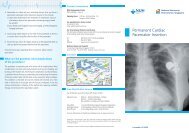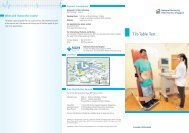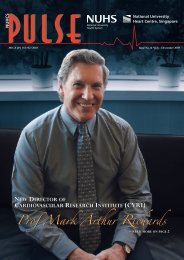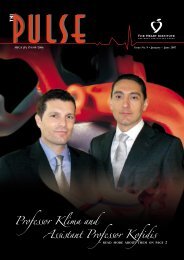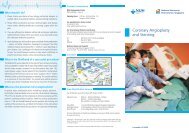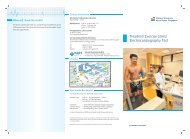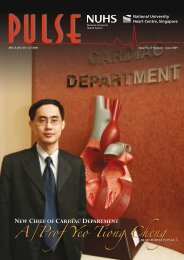Prof Chia Boon Lock receives the SMA Honorary ... - nuhcs
Prof Chia Boon Lock receives the SMA Honorary ... - nuhcs
Prof Chia Boon Lock receives the SMA Honorary ... - nuhcs
You also want an ePaper? Increase the reach of your titles
YUMPU automatically turns print PDFs into web optimized ePapers that Google loves.
MICA (P) 023/09/2007 Issue No. 11 • January – June 2008<br />
<strong>Prof</strong> <strong>Chia</strong> <strong>Boon</strong> <strong>Lock</strong> <strong>receives</strong> <strong>the</strong><br />
<strong>SMA</strong> <strong>Honorary</strong> Membership Award<br />
– READ MORE ABOUT IT ON PAGE 2
in this issue<br />
02<br />
04<br />
PROF CHIA BOON LOCK<br />
RECEIVED <strong>SMA</strong> HONORARY<br />
MEMBERSHIP AWARD<br />
UPCOMING PUBLIC SYMPOSIUM<br />
ON SUDDEN CARDIAC DEATH<br />
RECEIVING THE <strong>SMA</strong> HONORARY<br />
<strong>Prof</strong> <strong>Chia</strong> <strong>Boon</strong><br />
05<br />
06<br />
07<br />
08<br />
10<br />
MRCP (UK) PREPARATORY<br />
COURSE<br />
CAROTID ARTERY STENTING<br />
INFORMATION TECHNOLOGY @<br />
THE HEART INSTITUTE<br />
NHG HMDP EXPERT VISIT –<br />
A/PROF DAVID CAMPBELL<br />
1 ST SINGAPORE-ASIA CARDIAC<br />
RESYNCHRONISATION THERAPY<br />
COURSE<br />
CARDIAC REHABILITATION<br />
PROGRAMME<br />
16 TH ANNUAL CONGRESS OF THE<br />
ASIAN SOCIETY FOR<br />
CARDIOVASCULAR AND THORACIC<br />
SURGERY<br />
A/<strong>Prof</strong> Tan Huay Cheem, Chief, Cardiac<br />
11<br />
12<br />
13<br />
14<br />
16<br />
18<br />
20<br />
WET LAB WORKSHOP<br />
16 TH ASCVTS ENDOVASCULAR<br />
AORTIC STENTING COURSE<br />
SINGAPORE CARDIAC SOCIETY<br />
LECTURER AWARD<br />
FIRST PRIZE – YOUNG<br />
INVESTIGATOR’S AWARD<br />
CHICAGO ACC SUCCESS<br />
GIVING THE SICK HEART A BREAK<br />
NMRC GRANT AWARD<br />
COARCTATION STENTING –<br />
PERCUTANEOUS THERAPY FOR A<br />
RARE PROBLEM<br />
CIT BEIJING MEETING<br />
HAPPENINGS<br />
DIRECTORY AND AWARDS<br />
FEEDBACK<br />
Please direct your feedback to<br />
The Editor, PULSE<br />
c/o The Heart Institute<br />
National University Hospital<br />
Cardiac Department<br />
Level 3, Main Building<br />
Singapore 119074<br />
Tel 6772 5565<br />
Fax 6778 6057<br />
Email The_Heart_Institute@nuh.com.sg<br />
EDITOR<br />
Dr Poh Kian Keong<br />
ABSTRACTS, PUBLICATIONS AND<br />
NEW DOCTORS ON BOARD<br />
ADVISOR<br />
A/<strong>Prof</strong> Tan Huay Cheem<br />
Contents are not to be reproduced without <strong>the</strong><br />
permission of The Heart Institute<br />
“The name <strong>Prof</strong> <strong>Chia</strong> <strong>Boon</strong> <strong>Lock</strong>, immediately conjures up an image<br />
of a superb clinical cardiologist who can interpret any cardiac<br />
murmur accurately, a dedicated educator who enjoys imparting his<br />
knowledge to <strong>the</strong> medical students and <strong>the</strong> younger doctors, a clinical<br />
researcher devoted to <strong>the</strong> pursuit of <strong>the</strong> intricacies of <strong>the</strong><br />
electrocardiogram and above all, a fa<strong>the</strong>rly figure who is always<br />
willing to lend a hearing ear and who is also always unstinting<br />
with his advice.” This is <strong>the</strong> citation by Assoc <strong>Prof</strong> Tan Huay Cheem<br />
for <strong>Prof</strong>essor <strong>Chia</strong> <strong>Boon</strong> <strong>Lock</strong>, who was conferred honorary<br />
membership of <strong>the</strong> Singapore Medical Association for <strong>the</strong> Year 2008<br />
at <strong>the</strong> recent <strong>SMA</strong> Dinner.<br />
One of <strong>the</strong> early pioneers of cardiology in Singapore, <strong>Prof</strong><br />
<strong>Chia</strong> was in charge of cardiology in Medical Unit II (later known<br />
as <strong>the</strong> University Department of Medicine II) at SGH from 1975<br />
to 1985 and was also Head of this Department from 1981 to 1983.<br />
After moving over to NUH, he became Head of <strong>the</strong> hospital’s<br />
Division of Cardiology, Department of Medicine, from 1986 to<br />
1989 and Chief of <strong>the</strong> Cardiac Department from 1996 to 1999.<br />
Amongst his many achievements, he was one of <strong>the</strong> first two<br />
cardiologists to introduce echocardiography and <strong>the</strong> first to<br />
introduce ambulatory blood pressure monitoring in Singapore.<br />
<strong>Prof</strong> <strong>Chia</strong> is <strong>the</strong> current Chairman of <strong>the</strong> Ministry of Health<br />
Workgroup for <strong>the</strong> Clinical Practice Guidelines on Lipids and a<br />
Member of <strong>the</strong> Workgroup on Hypertension. He was formerly<br />
President of <strong>the</strong> Singapore Cardiac Society, Chairman of <strong>the</strong><br />
Chapter of Physicians, Academy of Medicine (now <strong>the</strong> College of<br />
Physicians, Singapore) and a Member of <strong>the</strong> 17 th and 18 th Council<br />
of <strong>the</strong> Singapore Medical Association.<br />
An outstanding and inspiring teacher who is a favourite of<br />
<strong>the</strong> NUS medical students and also registrars training in Cardiology,<br />
<strong>Prof</strong> <strong>Chia</strong> has contributed significantly to <strong>the</strong> training of generations<br />
of doctors and cardiologists in Singapore. For this and o<strong>the</strong>r<br />
contributions, <strong>the</strong> NUS conferred him <strong>the</strong> title of Emeritus <strong>Prof</strong>essor<br />
THI PULSE | 2
AWARD<br />
<strong>Lock</strong><br />
Dept<br />
@ NUH<br />
in 2006. O<strong>the</strong>r awards which he has received include <strong>the</strong> Lee<br />
Foundation-National Healthcare Group Lifetime Achievement Award<br />
and <strong>the</strong> Dato Paduka Mahkota Brunei.<br />
Remarkably, most of <strong>Prof</strong> <strong>Chia</strong>’s achievements have been<br />
attained despite a long battle with advanced nasopharyngeal<br />
carcinoma – initially with <strong>the</strong> treatment 24 years ago and<br />
subsequently with <strong>the</strong> late side-effects arising from <strong>the</strong> radio<strong>the</strong>rapy<br />
which he had received. This is truly a<br />
testimony of his great courage and his<br />
indomitable spirit.<br />
The award at <strong>the</strong> dinner was<br />
presented to <strong>Prof</strong> <strong>Chia</strong> by <strong>the</strong> Permanent<br />
Secretary of Health, Miss Yong Ying-I.<br />
THI PULSE | 3
UPCOMING SYMPOSIUM ON<br />
Sudden Cardiac Death<br />
Dr Abdul Razakjr Omar, Cardiac Dept @ NUH<br />
The Singapore Medical<br />
Association will be<br />
organising <strong>the</strong> 39 th <strong>SMA</strong><br />
Annual National Medical<br />
Convention on 5 th July<br />
2008 at <strong>the</strong> Raffles City<br />
Convention Centre. The<br />
Heart Institute, National<br />
Healthcare Group is privileged to co-host this year’s important<br />
national healthcare convention.<br />
The recent extensive and frequent media coverage of<br />
sudden death among our youth propelled <strong>the</strong> quest to educate our<br />
society about <strong>the</strong> issues related to sudden cardiac death. Therefore<br />
this year <strong>the</strong> <strong>the</strong>me for <strong>the</strong> medical convention is “Prevention of<br />
Sudden Cardiac Death: Perception and Reality”. We have <strong>the</strong><br />
pleasure of having <strong>the</strong> senior parliamentary secretary of health,<br />
Mr Hawazi Diapi to grace <strong>the</strong> occasion as our guest of honour.<br />
Despite a substantial reduction in age-adjusted rates of death<br />
from cardiovascular causes during <strong>the</strong> past 40 to 50 years,<br />
cardiovascular disease remains <strong>the</strong> single most common cause of<br />
natural death in developed nations. Sudden cardiac death (SCD) is<br />
estimated to account for approximately 50 percent of all deaths<br />
from cardiovascular causes. In US, it accounted for 20% of all deaths<br />
annually (>300,000 SCD), while in Europe ~100 SCD per 100<br />
000 and in our society ~ 1 per 1000 individuals.<br />
The majority of such sudden deaths are caused by acute<br />
ventricular tachyarrhythmias, often triggered by acute coronary<br />
events (coronary artery disease)<br />
Clinical trials have shown that antiarrhythmic- drug <strong>the</strong>rapy<br />
is not effective in reducing mortality among patients who are<br />
assumed to be at risk for such death, but recent randomized trials<br />
have demonstrated a survival benefit in high-risk patients of <strong>the</strong>rapy<br />
with an implantable cardioverter–defibrillator, compared to<br />
conventional drug <strong>the</strong>rapy.<br />
The Centers for Medicare and Medicaid Services estimate<br />
that as many as 500,000 Medicare beneficiaries might be eligible<br />
to receive a prophylactic ICD in <strong>the</strong> United States. Given <strong>the</strong><br />
substantial cost of <strong>the</strong> ICD, <strong>the</strong> economic effect of this strategy<br />
must be considered in future healthcare planning.<br />
The importance of educating all doctors on SCD should be<br />
recognized. The highlights of <strong>the</strong> Medical Convention will include<br />
a one-day medical symposium and workshop for healthcare<br />
professionals and public forum. The interesting program will be<br />
finalized by Dr Eric Hong & Dr Ong HY (Chairmans for Public<br />
Symposium) and Dr Seow SC (Scientific Chairman for Medical<br />
Symposium) focusing on prevention and latest management of SCD.<br />
MRCP (UK)<br />
Preparatory Course<br />
Dr Eric Hong, Cardiac Dept @ NUH<br />
The Final MMed (Int Med)/MRCP PACES Examination<br />
Preparatory Course was held from 14-19 April in various hospitals<br />
in Singapore under <strong>the</strong> auspices of <strong>the</strong> Division of Graduate Medical<br />
Studies, Yong Loo Lin School of Medicine. This was an intensive<br />
programme consisting of practice sessions in all stations of <strong>the</strong><br />
examination, culminating in a full<br />
mock examination on <strong>the</strong> last<br />
2 days of <strong>the</strong> course.<br />
The Heart Institute is<br />
proud to organize <strong>the</strong><br />
examination held in <strong>the</strong><br />
National University Hospital.<br />
This demonstrates <strong>the</strong><br />
department’s strong<br />
commitment in training<br />
new generation of young<br />
medical specialists.<br />
The examination<br />
was well received by <strong>the</strong><br />
participants. Many found<br />
<strong>the</strong> cases useful in honing<br />
<strong>the</strong>ir clinical skills assisted by tutors at hand who critique <strong>the</strong><br />
participants’ examination and presentation skills.<br />
THI PULSE | 4
Carotid Artery Stenting<br />
Dr Teo Swee Guan, Cardiac Dept @ NUH<br />
Percutaneous transluminal angioplasty and stenting have become<br />
an established <strong>the</strong>rapeutic modality for coronary and peripheral<br />
arterial diseases, complementing surgical treatment. The<br />
application of this technique in carotid artery stenosis is an<br />
expected progression. The perceived advantages of carotid artery<br />
stenting (CAS) compared to carotid endarterectomy (CEA)<br />
include avoidance of general anes<strong>the</strong>sia and open surgical incision,<br />
shorter procedural time and hospitalization, and increased<br />
patients’ acceptance.<br />
Since FDA approval of CAS in 2004, it has been increasingly<br />
used for patients considered as high risk for surgery. In contrast to<br />
most endovascular peripheral arterial interventions, CAS<br />
represents a more challenging procedure because it requires <strong>the</strong><br />
use of smaller guidewire system (0.014-in vs 0.035-in guidewire<br />
system as in peripheral intervention), distal embolic protection<br />
device and rapid exchange system (vs. over-<strong>the</strong>-wire system). The<br />
use of long guiding sheath via common femoral artery to perform<br />
balloon angioplasty and stenting also represents new challenge for<br />
physicians with less CAS experience.<br />
CEA has long been <strong>the</strong> gold standard for <strong>the</strong> treatment of<br />
carotid artery stenosis. In North American Symptomatic Carotid<br />
Endarterectomy Trial (NASCET), symptomatic patients with<br />
carotid artery stenosis (70-99%) in CEA arm compared to medical<br />
group had higher perioperative stroke/death (5.8% vs 3.3%) but<br />
significantly lower major/fatal ipsilateral stroke at 2 years (2.5%<br />
vs 13.1%, p
SPOTLIGHT<br />
Information Technology<br />
@ The Heart Institute<br />
Dr James Yip & Ms Fauziah Azizi, Cardiac Dept @ NUH<br />
Within <strong>the</strong> ‘heart’ of operations at <strong>the</strong> The Heart Institute runs a<br />
unique software that has been storing critical information of our<br />
patients since 1991. This database, <strong>the</strong> cardiology information<br />
system (CIS) was initially spawned by <strong>Prof</strong>essor Maurice Choo,<br />
when he was <strong>the</strong>n chief of <strong>the</strong> cardiac department in NUH. It was<br />
initially a report generator for our echocardiography, treadmill<br />
and ambulatory blood pressure investigations and networked on a<br />
series of Macintosh computers. In 1998, <strong>the</strong> system was revamped<br />
to include research data and a new engine which helped<br />
cardiologists track <strong>the</strong>ir cases. In 2000, <strong>the</strong> system was moved to a<br />
Windows platform and <strong>the</strong> system was exported to Alexandra<br />
Hospital for use. It also boasted of a hospital interface which allowed<br />
its reports to be seen in NUH’s Hospital information system. We<br />
also developed an expert system for our percutaneous interventions<br />
which allowed full text reports to be generated from data captured<br />
during a procedure. We expanded our repertoire of investigations<br />
in <strong>the</strong> system to include 35 unique cardiology investigations ranging<br />
from Nuclear, CT angiography, Cardio-pulmonary exercise,<br />
Electrophysiology, congenital heart and vascular interventions.<br />
In 2001, we bravely entered <strong>the</strong> world of real time digital<br />
imaging. We began storing all images from echocardiography,<br />
cardiac ca<strong>the</strong>terization, electrocardiograms and nuclear. One of<br />
our overriding principles, was that all ‘raw’ source data from any<br />
system had to be stored and shared with everyone. In 2003, this<br />
database was installed in Tan Tock Seng Hospital and a National<br />
Heathcare Group (NHG) cardiology network was established. Our<br />
cardiology reports became available to <strong>the</strong> whole cluster in 2005<br />
on <strong>the</strong> computerized patient record system (CPRS). In 2003, we<br />
won a grant from The Enterprise Challenge from <strong>the</strong> Prime<br />
Minister’s office and we became <strong>the</strong> first medical unit in Singapore<br />
to use tablet personal computers for our daily ward rounds. This<br />
allowed all cardiology reports and images to be disseminated to<br />
<strong>the</strong> patients bedside. This improved our overall efficiency and<br />
allowed patients to have a shorter length of stay for our inpatients.<br />
In 2004, our CIS won <strong>the</strong> prestigious National Infocomm Awards<br />
from <strong>the</strong> Infocomm Development Authority (IDA) for <strong>the</strong> best<br />
implementation of IT in a public institution. In 2005, our IT<br />
director, Dr James Yip was inducted into <strong>the</strong> IT Hall of Fame of<br />
<strong>the</strong> Singapore Computing Society for <strong>the</strong> Friend of IT award.<br />
On a daily basis, <strong>the</strong> CIS allows our cardiologists to review<br />
patient information on a timely basis and to complete <strong>the</strong>ir<br />
cardiology reports. It has <strong>the</strong> capacity, for our doctors to work<br />
from home and to store interesting cases for teaching and research.<br />
The CIS contains coded fields which allows directed research to<br />
be conducted by our cardiologists and data to be collected<br />
prospectively. Thanks to this database, our research output each<br />
year grows by leaps and bounds, and doctors are able to submit<br />
numerous abstracts for local and overseas meetings, with some<br />
our young researchers frequently clinching young investigator<br />
awards. Part of <strong>the</strong> success of our CIS system, is that it is self<br />
developed and self managed. It is an organism which continually<br />
evolves to meet <strong>the</strong> new challenges, which is what expensive<br />
proprietary systems cannot promise to deliver. In <strong>the</strong> future<br />
development of <strong>the</strong> CIS, we hope to increase its connectivity<br />
to o<strong>the</strong>r systems and to deliver clinical decision support for<br />
<strong>the</strong> cardiologists.<br />
THI PULSE | 6
NHG HMDP EXPERT VISIT 26-20 MAY 2008<br />
A/<strong>Prof</strong> David Campbell<br />
A/<strong>Prof</strong> Peter Robless & Dr Benjamin Chua, CTVS @ NUH<br />
The Department of Cardiac, Thoracic & Vascular Surgery at NUH<br />
was honoured to host <strong>Prof</strong> David Campbell from Beth Israel<br />
Deaconess Hospital and Harvard Medical School, Boston, USA<br />
during his visit as NHG HMDP Expert in Vascular Surgery. <strong>Prof</strong><br />
Campbell is one of <strong>the</strong> most well-known figures in <strong>the</strong> field of limb<br />
salvage bypass surgery for peripheral vascular disease and diabetic<br />
foot preservation. His group in Boston have published extensively<br />
on limb salvage surgical techniques and outcomes for <strong>the</strong> last 20<br />
years and <strong>the</strong>ir results for limb salvage and low perioperative<br />
mortality are <strong>the</strong> gold standards o<strong>the</strong>rs aim for.<br />
<strong>Prof</strong> Campbell’s visit included a mix of lectures and<br />
demonstration surgery, in addition to a vascular anastomosis<br />
masterclass. In his series of lectures, he shared with an extensive<br />
audience of surgeons, physicians and anaes<strong>the</strong>tists, <strong>the</strong> experience<br />
and outcomes from his surgical series numbering more than 6000<br />
lower limb bypass surgeries.<br />
<strong>Prof</strong> Campbell has been instrumental in developing diabetic<br />
limb salvage programmes in <strong>the</strong> Vietnam and India in <strong>the</strong> last<br />
decade. He has been traveling to hospitals in Hanoi, Danang and<br />
Ho Chi Minh City for <strong>the</strong> last ten years to promote limb salvage<br />
and has reported this in <strong>the</strong> Bulletin of <strong>the</strong> American College of<br />
Surgeons. It was during one of <strong>the</strong>se trips that he met <strong>Prof</strong> KO<br />
Lee from <strong>the</strong> Dept of Endocrinology at NUH and was invited to<br />
visit Singapore to promote diabetic limb salvage.<br />
He was welcomed at NUH by <strong>the</strong> vascular surgery,<br />
endocrine, renal and diabetic foot teams. <strong>Prof</strong> Campbell assisted<br />
in two patients undergoing carotid endarterectomies. He also<br />
visited <strong>the</strong> vascular surgery units at Singapore General Hospital<br />
and Tan Tock Seng Hospital, where he participated in <strong>the</strong> vascular<br />
radiology meetings. At TTSH, he demonstrated his techniques of<br />
distal bypass surgery. Despite his busy schedule, <strong>Prof</strong> Campbell<br />
also found time to conduct a masterclass on vascular anastomotic<br />
techniques using animal cadaveric vessels models held in <strong>the</strong><br />
SmartLab of <strong>the</strong> Advanced Surgery Training Centre at NUH.<br />
Supported by Ethicon, J&J and Terumo Vascutek, it was well<br />
attended by an enthusiastic group of 10 surgeons and advanced<br />
surgery trainees. <strong>Prof</strong> Campbell remarked that, “This is <strong>the</strong> most<br />
number of surgeons I have trained in one afternoon ever!” Valuable<br />
lessons in surgical technique and a great time by all. He was also<br />
<strong>the</strong> guest of honour at a dinner hosted by <strong>the</strong> Vascular Surgical<br />
Society of Singapore held at <strong>the</strong> Peranakan restaurant,True Blue<br />
in Armenien Street. This was indeed a novel culinary experience<br />
for our visiting New England surgeon.<br />
<strong>Prof</strong> Campbell delivered his talk on “Infection,<br />
Neuropathy and Arterial Insufficiency in <strong>the</strong> Diabetic” at <strong>the</strong> NUH<br />
hospital grand rounds. After that he participated in <strong>the</strong> Diabetic<br />
Foot Ward Rounds conducted by <strong>Prof</strong> Aziz Na<strong>the</strong>r and <strong>the</strong> NUH<br />
diabetic foot team, where he shared his knowledge and experience<br />
in management in diabetic patients with foot wounds. This ward<br />
round was well-received and attended by a large group of surgeons,<br />
nurses and podiatrist.<br />
<strong>Prof</strong> Campbell’s visit as HMDP Expert was a resounding<br />
success, judging from <strong>the</strong> number of people who attended his<br />
lectures, ward rounds and masterclass. It was our pleasure to host<br />
his visit and we certainly hope that he too had a great time and will<br />
visit us again soon.<br />
THI PULSE | 7
don’t bypass Cardiac Rehabilitation<br />
Dr Eric Hong, Cardiac Dept @ NUH<br />
Cardiac rehabilitation is increasingly<br />
recognised as an integral component of<br />
<strong>the</strong> continuum of care for patients with<br />
cardiovascular disease. Its application is a<br />
class I recommendation in most<br />
contemporary cardiovascular clinical<br />
practice guidelines. Despite <strong>the</strong><br />
documentation of substantial morbidity<br />
and mortality benefits, cardiac<br />
rehabilitation services are vastly underutilised.<br />
Established in <strong>the</strong> late 1990s, <strong>the</strong> Cardiac<br />
Rehabilitation Programme (CRP) at National University<br />
Hospital (NUH) is characterized with a provisional<br />
comprehensive long term services involving medical evaluation,<br />
prescriptive exercise; cardiac risk factor modification, education,<br />
counseling and behavioural interventions.<br />
It is paramount that a good CRP is multifaceted and<br />
multidisciplinary in nature consisting doctors, specialized cardiac<br />
nurses, physio<strong>the</strong>rapists, dietitians, pharmacists, medical social<br />
workers, occupational <strong>the</strong>rapists, psychologist and psychiatrist. In<br />
NUH, cardiologist Dr. Eric Hong Cho Tek leads this unique<br />
specialised individualised programme. Dr Roger Ho, a psychiatrist,<br />
is also part of this dynamic<br />
multidisciplinary team.<br />
Upon <strong>the</strong> completion of <strong>the</strong><br />
National University Heart Centre for<br />
Cardiovascular Services, a dedicated<br />
cardiac rehabilitation gym with <strong>the</strong><br />
state-of-<strong>the</strong>-art exercise equipment<br />
and facilities will help to meet <strong>the</strong><br />
needs of <strong>the</strong> evolving society.<br />
Numerous studies have demonstrated that cardiac<br />
rehabilitation programmes can reduce <strong>the</strong> cardiac death rate by as<br />
much as 20 to 25 per cent. It has been shown to be as important as<br />
compliance to prescribed medication and following, of a strict<br />
recommended diet. Despite <strong>the</strong> presence of cardiac rehabilitation,<br />
only 15 to 20 per cent of appropriate candidates participated in a<br />
formal CRP in Singapore. In our survey, most quoted ignorance<br />
of <strong>the</strong> existence of a CRP.<br />
In NUH CRP, our goals are manifolds. Besides reducing<br />
morbidity and mortality, improvement of <strong>the</strong> quality of life,<br />
reduction in subsequent rehospitalization, and getting patient<br />
back to normality, if not better. We provide supervised exercise<br />
training, multidisciplinary education programme to patients<br />
1 st Singapore-Asia Cardiac Resynchronisation<br />
Dr Seow Swee Chong & Dr Abdul Razakjr Omar, Cardiac Dept @ NUH<br />
Heart failure is a major public health issue in developed countries,<br />
exacting a heavy toll on medical resources and more importantly,<br />
a high mortality and morbidity on <strong>the</strong> patients. Until recently, little<br />
o<strong>the</strong>r than medication could be done for patients with chronic heart<br />
failure who are not suitable for coronary revascularization or cardiac<br />
transplant. Patients were forced to restrict <strong>the</strong>ir activities often to<br />
minimally functional levels to adapt to <strong>the</strong>ir poor heart function<br />
while <strong>the</strong>y lived <strong>the</strong>ir lives under <strong>the</strong> spectre of certain death by<br />
progressive heart failure or sudden cardiac arrest.<br />
The advent of device <strong>the</strong>rapy for chronic heart failure has<br />
literally brought new life and hope for <strong>the</strong>se patients. Individuals<br />
with very poor heart function often have uncoordinated contraction<br />
of <strong>the</strong>ir heart walls. By implanting a pacemaker with multiple leads,<br />
<strong>the</strong>se walls can be made to move toge<strong>the</strong>r again in a coordinated,<br />
synchronized fashion resulting in improved symptoms, cardiac<br />
output and even a reduction in mortality. Aptly termed “cardiac<br />
resynchronization <strong>the</strong>rapy” (CRT), this modality has been shown<br />
in large clinical trials to reverse <strong>the</strong> process of progressive heart<br />
enlargement seen in chronic heart failure.<br />
Heart failure patients are also at high risk of sudden cardiac<br />
arrest due to life-threatening heart rhythm abnormalities. By<br />
combining a CRT pacemaker with a defibrillator in a single device,<br />
this o<strong>the</strong>r major cause of death in heart failure is addressed, and<br />
results in a fur<strong>the</strong>r reduction in mortality in <strong>the</strong> COMPANION<br />
and MIRACLE-ICD trials.<br />
THI PULSE | 8
Programme<br />
recovering from cardiac events such as a heart attack,<br />
interventional procedures like angioplasty, heart surgery (bypass,<br />
transplant or valvular) and congestive heart failure. This is to<br />
target <strong>the</strong> motivated individuals who want to reduce traditional<br />
cardiovascular risk factors. In NUH, we have also developed a<br />
dedicated smoking cessation programme<br />
In our experience, we are aware that many cardiac<br />
patients have high levels of stress and anxiety. Depression is<br />
prevalent after acute cardiac events, with 20 to 45 per cent<br />
of patients having significant depression after acute myocardial<br />
infarction (AMI). Depression is an independent risk factor<br />
for mortality in patients with AMI, or unstable angina. Several<br />
studies suggest improvement with cardiac rehabilitation<br />
intervention. Patients with depressive symptoms have a fivefold<br />
increased risk of non-completion of cardiac rehabilitation<br />
and <strong>the</strong>refore require enhanced attention and support. We<br />
have also dedicated a team to focus on neuropsychological<br />
aspect of <strong>the</strong>se patients.<br />
A review of 46 randomised trials of secondary<br />
prevention, in 18821 patients with coronary heart disease was<br />
recently conducted by <strong>the</strong> agency for Health care research and<br />
quality: Secondary prevention programs were demonstrated to<br />
reduce hospitalization, recurrent MI and long term mortality.<br />
Physicians can initiate <strong>the</strong> referral if <strong>the</strong>ir patient is appropriate<br />
for CRP in NUH.<br />
Please visit www.nuh.com.sg/_cardiac/<br />
ourServices_cardiacRehabilitation.htm or contact<br />
<strong>the</strong> CRP nurses for more information.<br />
Lai Shuet Ming – 67725563 / 95402582<br />
Rachel Chan Wang Hia – 67722436 / 95669078<br />
Ooi Lean See – 67722497 / 98028205<br />
(CRT) Therapy Course<br />
It is little wonder <strong>the</strong>refore that <strong>the</strong>re is much interest<br />
worldwide in <strong>the</strong> technique of performing CRT implants, which<br />
is more complex than a routine pacemaker implant. With <strong>the</strong><br />
generous support of St Jude Medical, <strong>the</strong> Cardiac Department at<br />
<strong>the</strong> National University Hospital was able to conduct <strong>the</strong> 1 st<br />
Singapore-Asia CRT implant course, which hosted foreign doctors<br />
from South Korea and <strong>the</strong> Philippines. Over <strong>the</strong> course of 3 days<br />
from 28 th till 30 th April 2008, live cases of CRT implant were<br />
performed, spaced apart by didactic lectures on <strong>the</strong> indications<br />
and trial evidence for such <strong>the</strong>rapy as well as methods for<br />
optimization of CRT devices post-implant. Led by course directors<br />
Dr Abdul Razakjr Omar and Dr Seow Swee Chong, <strong>the</strong> programme<br />
also included a practical session demonstrating optimization of <strong>the</strong><br />
devices using echocardiography.<br />
With overwhelmingly positive feedback from course<br />
participants, <strong>the</strong> Department is geared up to continue conducting<br />
such courses on a regular basis; sharing knowledge and<br />
experiences and fostering friendships with fellow cardiologists<br />
across <strong>the</strong> region.<br />
THI PULSE | 9
16 th Annual Congress of <strong>the</strong> Asian Society<br />
for Cardiovascular and Thoracic Surgery<br />
<strong>Prof</strong> Uwe Klima, CTVS @ NUH<br />
Singapore hosted <strong>the</strong> 16 th Annual Congress<br />
of <strong>the</strong> Asian Society for Cardiovascular and<br />
Thoracic Surgery (ASCVTS) held over 13–<br />
16 March 2008 under <strong>the</strong> Chairmanship of<br />
<strong>Prof</strong>essor Lee Chuen-Neng, Chair, University<br />
Surgical Cluster, Head, Department of<br />
Surgery and Department of Cardiac, Thoracic<br />
& Vascular Surgery, National University<br />
Health System. It was attended by over 870 participants from 50<br />
countries.<br />
Since its foundation in 1993, <strong>the</strong> ASCVTS had become<br />
<strong>the</strong> largest cardiothoracic Society In Asia. Its goals have been to<br />
promote <strong>the</strong> study of <strong>the</strong> art, science and practice of cardiovascular<br />
surgery, hence facilitating <strong>the</strong> exchange of ideas in <strong>the</strong> field of<br />
cardiovascular surgery. Journeying into <strong>the</strong> 21 st century,<br />
advancements in <strong>the</strong> field of healthcare have been accompanied<br />
by unexpected challenges and greater responsibilities. The <strong>the</strong>me<br />
this year – “Putting Patients first in <strong>the</strong> Era of Modern Technology”,<br />
embodies <strong>the</strong> purpose of this congress, which is to equip healthcare<br />
personnel as well as patients with medical knowledge that is<br />
becoming increasingly relevant in our society.<br />
wet lab workshop<br />
For <strong>the</strong> first time outside of America, <strong>the</strong> American<br />
Association for Thoracic Surgery (AATS) held a post-graduate<br />
review course. This was well received.<br />
The congress received over 250 free paper submission, of<br />
which 50% were for oral presentation over 14 sessions and 50%<br />
were for poster presentation. Alongside <strong>the</strong> main congress, several<br />
workshops namely <strong>the</strong> Haemodynamic Workshop, Endovascular<br />
Aortic Stenting Course and Minimally Invasive Thoracic<br />
Symposium were conducted at <strong>the</strong> Advanced Surgery Training<br />
Centre, National University Hospital. All <strong>the</strong> workshops were<br />
convened by our doctors with international and regional panelists.<br />
The nursing symposium which was attended by more than<br />
200 participants was coordinated by a nursing committee<br />
represented by all <strong>the</strong> major hospitals in Singapore.<br />
<strong>Prof</strong> Uwe Klima, CTVS @ NUH<br />
In conjunction with ASCVTS 2008, St. Jude Medical took <strong>the</strong><br />
opportunity to run a wet lab workshop on <strong>the</strong> 12 th March 2008.<br />
A total of 11 doctors, coming from various Asia countries<br />
participated in <strong>the</strong> workshop which was held at <strong>the</strong> Advanced<br />
Surgical centre at <strong>the</strong> National University Hospital of Singapore.<br />
The workshop was conducted by <strong>Prof</strong> Uwe Klima and A/<strong>Prof</strong><br />
Theodoros Kofidis from <strong>the</strong> National University Hospital and Dr<br />
Chua Yeow Leng from <strong>the</strong> National Heart Center.<br />
The workshop started with Dr Chua sharing a presentation on<br />
HIFU (High Intensity Focus Ultrasound) technology for open cardiac<br />
ablation for <strong>the</strong> treatment of Atrial Fibrillation. He shared <strong>the</strong><br />
differences between HIFU and o<strong>the</strong>r technologies, as well as <strong>the</strong><br />
method of performing a procedure using <strong>the</strong> EPICOR machine. The<br />
main advantage for HIFU is <strong>the</strong> ability to provide<br />
transmural ablation effectively and safely.<br />
There was also a short hands-on session<br />
where Dr Chua demonstrated an ablation<br />
using EPICOR on a porcine heart.<br />
This was followed by <strong>Prof</strong> Klima giving a presentation on<br />
<strong>the</strong> treatment of Valvular Disease using MHV (Mechanical Heart<br />
Valves). Regent TM valve was highlighted as one of <strong>the</strong> best performing<br />
MHV with outstanding performance for EOAI (Effective Orific Area<br />
Index) and profile. A/<strong>Prof</strong> Kofidis spoke on Current Trend for Tissue<br />
Heart Valves, <strong>the</strong> Epic TM Heart Valves was featured for its superb<br />
profile and unique anticalcification technology. The participants<br />
broke out into smaller groups where <strong>the</strong> trainers gave a detailed<br />
demonstration on <strong>the</strong> tips and tricks of sewing <strong>the</strong> Regent TM valve<br />
and Epic TM Supra valve onto a porcine heart. Each participant also<br />
had a chance to assist or replace a valve onto a porcine heart under<br />
<strong>the</strong> supervision of <strong>the</strong> trainers.<br />
Overall, <strong>the</strong> feedback and response towards <strong>the</strong> workshop<br />
have been positive. All participants mentioned that <strong>the</strong>y found <strong>the</strong><br />
session insightful, and <strong>the</strong> various advice given by <strong>the</strong> trainers during<br />
<strong>the</strong> session were invaluable in helping <strong>the</strong>m provide better patient<br />
care through better techniques and skills learn through <strong>the</strong> workshop.<br />
THI PULSE | 10
16 th ASCVTS Endovascular<br />
Aortic Stenting Course<br />
A/<strong>Prof</strong> Peter Robless, CTVS @ NUH<br />
The 16 th Annual<br />
Meeting of <strong>the</strong><br />
Asian Society for<br />
CardioVascular &<br />
Thoracic Surgery<br />
was held from <strong>the</strong><br />
12–16 th March<br />
2008 in Singapore.<br />
As part of <strong>the</strong><br />
meeting, <strong>the</strong> Heart<br />
Institute was pleased<br />
to host <strong>the</strong> ASCVTS Endovascular Aortic Stenting Course held at<br />
<strong>the</strong> Tan Sri Khoo Teck Puat Advanced Surgery Training Centre at<br />
<strong>the</strong> National University Hospital on <strong>the</strong> 15 th March 2008. The<br />
workshop was fully subscribed with over 60 delegates from<br />
Singapore, Indonesia, Phillipines, India, Taiwan, Thailand, Malaysia<br />
and Japan attending.<br />
We were pleased to bring toge<strong>the</strong>r an international faculty<br />
of eminent cardiovascular surgeons and interventionists involved<br />
in <strong>the</strong> training and development of thoracic endovascular aortic<br />
stenting programs. The guest faculty included Drs Roy Greenberg,<br />
Joe Bavaria, John Wolfe, Wei Zhou, Bart Muhs, Hassan Tehrani,<br />
Stephen Cheng, Ian Nixon, Shih Chun Che and Sophia Ang.<br />
This workshop aimed to address <strong>the</strong> practical aspects of patient<br />
selection, planning, case preparation and stent deployment. The<br />
current evidence base for thoracic aortic endovascular stenting was<br />
also presented and discussed.<br />
The participants were able to have a practical hands on<br />
demonstration of <strong>the</strong> leading thoracic aortic stentgrafts in clinical<br />
use such as <strong>the</strong> Gore TAG, Medtronic Valiant, COOK TX2 and<br />
Djumbodis Saint Come Chirurgie. There was intense interaction<br />
with experienced physician proctors and technical product specialists<br />
from <strong>the</strong> manufacturers.<br />
In addition to didactic presentations and small group handson<br />
demonstration <strong>the</strong>re was also interactive case discussions. In<br />
order to promote participation and discussion, several of <strong>the</strong> faculty<br />
brought <strong>the</strong>ir own teaching cases which were prepared on our 3-D<br />
Dextrobeam workstation for planning and discussion. This was<br />
facilitated by Dr Luis Serra and <strong>the</strong> team from Volume Interactions.<br />
This unique combination allowed <strong>the</strong> audience to view cases in <strong>the</strong><br />
standard axial, coronal and sagitall planes as well as in 3-D to fully<br />
appreciate <strong>the</strong> tortousity, landing zones, branching and access issues<br />
in thoracic endografting. Several cases involving thoracic aortic<br />
aneurysms, dissection and traumatic transections were discussed.<br />
Endovascular strategies involving hybrid repair of <strong>the</strong> thoracic aorta<br />
were also presented.<br />
THI PULSE | 11
Singapore Cardiac Society lecturer award<br />
Associate <strong>Prof</strong>essor<br />
Tan Huay Cheem is<br />
honoured as <strong>the</strong><br />
Singapore Cardiac<br />
Society Lecturer for<br />
Year 2008 at its<br />
recently held Annual<br />
Scientific Meeting<br />
(ASM). This is an<br />
award bestowed upon member who has contributed significantly<br />
to <strong>the</strong> Society. A/<strong>Prof</strong> Tan has served in <strong>the</strong> Council of <strong>the</strong> Society<br />
for <strong>the</strong> last 9 years since 1999, and was <strong>the</strong> Secretary, Vice<br />
President and eventually President of <strong>the</strong> Society for two terms<br />
from 2003–2005. He has contributed actively to many of <strong>the</strong><br />
Society’s continuing educational activities including helping to<br />
organize <strong>the</strong> 13 th SCS Annual ASM in Year 2000 and many<br />
international meetings such as <strong>the</strong> 13th ASEAN Congress of<br />
Cardiology in Year 2000 and 14 th Asian-Pacific Society of<br />
Cardiology in Year 2003. Cited by Dr Richard Ng, President of<br />
<strong>the</strong> SCS, A/<strong>Prof</strong> Tan is described as a dynamic and winsome doctor<br />
who is popular with both patients and colleagues locally and abroad<br />
for his enthusiastic and invaluable collaboration and fellowship. In<br />
his lecture, A/<strong>Prof</strong> Tan gave his insights on <strong>the</strong> “Management of<br />
Coronary Artery Disease-Diagnostic and Therapeutic Advances” which<br />
was warmly received by <strong>the</strong> audience.<br />
FIRST PRIZE<br />
Young Investigator’s Award<br />
Dr Chan Wan Xian, Cardiac Dept @ NUH<br />
It started with our department’s research grand round. After<br />
presenting my project entitled “Cardiorespiratory Gas Exchange<br />
Analysis During Dynamic Exercise Predicts Surgical Indications<br />
for Severe Mitral Regurgitation”, fellow colleagues encouraged<br />
<strong>the</strong> submission to <strong>the</strong> annual Singapore Cardiac Society meeting.<br />
I started working with my mentor, <strong>Prof</strong> Ling LH, to beat <strong>the</strong><br />
dateline of submission. We went through our data and statistics<br />
many times to draw accurate conclusions from months of hard<br />
work of patient recruitment and data collection. We <strong>the</strong>n<br />
proceeded with <strong>the</strong> drafting of our abstract and finally submitting<br />
just before <strong>the</strong> deadline.<br />
After weeks of waiting, I received an e-mail from <strong>the</strong><br />
Singapore Cardiac Society notifying us that <strong>the</strong> abstract has been<br />
selected for presentation at <strong>the</strong> Young Investigators’ Award session<br />
at <strong>the</strong> annual Singapore Cardiac Society Meeting. I immediately<br />
started preparing for <strong>the</strong> presentation.<br />
Our post-graduate education director, Dr Poh KK, arranged<br />
a practice session for us to present our studies to <strong>the</strong> department<br />
before <strong>the</strong> actual presentation. I was not fluent in my presentation.<br />
Fortunately, many colleagues from <strong>the</strong> department gave valuable<br />
comments from presentation style to slides content. That provided<br />
me feedback to reflect and improve.<br />
After that were<br />
sleepless nights to<br />
modify my presentation<br />
contents and to rehearse<br />
my presentation style.<br />
Seniors and secretaries<br />
from <strong>the</strong> department<br />
lent <strong>the</strong>ir help in all ways<br />
<strong>the</strong>y could. Special<br />
acknowledgements to<br />
Dr. James Yip, who lent me his books and articles on CPET and spent<br />
time explaining to me <strong>the</strong> concepts of CPET; and my mentor, <strong>Prof</strong> Ling,<br />
who patiently corrected my presentation and gave me invaluable advice.<br />
The presentation itself was an experience which one could<br />
not learn from books. It also provided me an opportunity to<br />
learn from my competitors, research methods and presentation<br />
skills. It widened my exposure to ongoing cardiovascular research<br />
in o<strong>the</strong>r instituitions.<br />
I feel most honoured to win <strong>the</strong> Young Investigator’s Award.<br />
I will continue to put in my best efforts and hope to do well in <strong>the</strong><br />
coming Asean’s Young Investigators’ Award presentation in Hanoi.<br />
THI PULSE | 12
Chicago ACC Success<br />
Dr<br />
Eric Chong, Cardiac Dept @ NUH<br />
American College of Cardiology<br />
Annual Scientific Meeting was held at<br />
Chicago this year. We had an<br />
outstanding 8 abstract presentations<br />
during <strong>the</strong> meeting. Dr Poh KK from<br />
our department was an invited faculty<br />
speaker in <strong>the</strong> echo seminar (E3:<br />
Essential Echocardiology with Experts)<br />
and A/<strong>Prof</strong> Tan HC was <strong>the</strong> only<br />
invited Singaporean faculty member at<br />
<strong>the</strong> ACC/SCAI (Society of Cardiovascular Angiography &<br />
Intervention) i2 Interventional Cardiology Summit meeting. It was<br />
snowing and freezing in Chicago at <strong>the</strong> beginning of <strong>the</strong> meeting.<br />
But <strong>the</strong> huge attending crowds warmed up <strong>the</strong> entire conference<br />
hall. Every room was crowded with attendees from all over <strong>the</strong><br />
world and it was hard to find oneself a standing place during <strong>the</strong><br />
more popular talks. Many world renowned speakers from<br />
institutions like <strong>the</strong> Cleveland and Mayo clinic gave impressive<br />
lectures. Dr Poh KK spoke on imaging of right heart masses which<br />
was well received by <strong>the</strong> packed<br />
international audience. In addition, Dr<br />
Abdul Razakrj bin Omar was<br />
conferred <strong>the</strong> ACC Fellowship at <strong>the</strong><br />
meeting. A/<strong>Prof</strong> Tan HC arranged a<br />
wonderful dinner meeting at a<br />
restaurant called <strong>the</strong> “Hugo Frogs”.<br />
This restaurant was so named because<br />
of its famous fried frog leg dishes.<br />
However, I think our Singapore styled<br />
frog dishes taste even better. It was a great pleasure to meet up<br />
with all <strong>the</strong> overseas NUH doctors in training during <strong>the</strong> dinner.<br />
Mark, Raymond, Chao Yang and Caroline gave speeches about <strong>the</strong>ir<br />
training in <strong>the</strong> States and shared <strong>the</strong>ir wonderful experiences. It<br />
was great to learn that NUH has provided us with a solid foundation<br />
in cardiology before <strong>the</strong> HMDP overseas stint. This was our first<br />
ever alumni ga<strong>the</strong>ring overseas. We hope that everyone will meet<br />
again in <strong>the</strong> next year’s ACC. It’s a truly memorable experience.<br />
FOR THE BETTER<br />
giving <strong>the</strong> sick heart a break...<br />
Goh Si Guim, CTVS @ NUH<br />
Heart disease is one of <strong>the</strong> leading causes of death worldwide.<br />
Open-heart surgery is a major operation indicated for<br />
patients to bring about relief of <strong>the</strong>ir debilitating symptoms and<br />
cardiac dysfunction.<br />
The surgeon requires a motionless heart and a bloodless<br />
field to do his job. Blood that normally course through <strong>the</strong> heart<br />
and lungs is diverted to <strong>the</strong> Heart Lung Machine. This provides<br />
an alternative and artificial means of keeping <strong>the</strong> blood going,<br />
mimicking <strong>the</strong> natural organs it replaces. The process is called<br />
cardiopulmonary bypass or more commonly known as Heart<br />
Bypass Surgery. The vital functions of <strong>the</strong> heart and lungs are<br />
now being performed by a mechanical device that works like <strong>the</strong><br />
real organs but look far from it!<br />
Once cardiopulmonary bypass is established, <strong>the</strong> heart is<br />
paralysed and <strong>the</strong> lungs shut down. The surgeon <strong>the</strong>n go about<br />
mending <strong>the</strong> hibernating heart.<br />
To quote one of our surgeons, “<strong>the</strong>se hearts get to rest,<br />
not ours!”<br />
Perfusionist is an alliedhealth<br />
specialty intimately<br />
related to cardiac surgery.<br />
They work alongside <strong>the</strong><br />
surgeons, anes<strong>the</strong>tists and<br />
nurses. They are specially trained professionals who manage <strong>the</strong><br />
heart lung machine and provide optimal life support for patients<br />
undergoing heart surgery.<br />
Cardiopulmonary bypass is a form of “insult” to <strong>the</strong><br />
integrity of <strong>the</strong> human body.”<br />
It elicits a host of adverse responses that put patient at<br />
fur<strong>the</strong>r risks. However, it is a necessary evil, from which, most<br />
patients benefit, coming out of it with a renewed lease of life. It<br />
enables <strong>the</strong>m to get back on with things <strong>the</strong>y would o<strong>the</strong>rwise be<br />
too incapacitated to perform.<br />
Today, some heart surgery procedures can be done without<br />
<strong>the</strong> need of <strong>the</strong> heart lung machine, known as beating heart surgery.<br />
Robotics is ano<strong>the</strong>r exciting advancement that has entered <strong>the</strong><br />
realm of heart surgery.<br />
THI PULSE | 13
NMRC Winning Grant<br />
Dr Chen Lin Yee, Cardiac Dept @ NUS, NUH<br />
“Identification of Novel Genetic Determinants<br />
of Atrial Fibrillation in an Asian Population”<br />
is a continuation of my research focus that<br />
started when I was undergoing cardiology and<br />
cardiac electrophysiology training at <strong>the</strong> Mayo<br />
Clinic College of Medicine, Rochester, MN.<br />
With start-up funds from <strong>the</strong> Yong Loo Lin<br />
School of Medicine, and <strong>the</strong> support of <strong>the</strong> Cardiac Department,<br />
NUH, and Department of Medicine, NUS, I started to lay <strong>the</strong><br />
groundwork for this project in August 2006. The process was made<br />
significantly easier through <strong>the</strong> guidance and mentorship of <strong>Prof</strong><br />
<strong>Chia</strong> Kee Seng, Center for Molecular Epidemiology, and Assoc <strong>Prof</strong><br />
Ling Lieng Hsi, Cardiac Department, NUH.<br />
Atrial fibrillation (AF) is <strong>the</strong> most common sustained arrhythmia,<br />
reaching epidemic proportions in <strong>the</strong> aging population, and resulting<br />
in significant morbidity, mortality, and socioeconomic burden. In a<br />
subset of younger patients (
1. Identify disease susceptibility polymorphisms for AF using<br />
candidate gene association analysis<br />
2. Define interaction of genetic factors with acquired factors in<br />
modifying AF risk and phenotypic expression<br />
3. Pave <strong>the</strong> way toward establishing a larger cohort to facilitate<br />
genome-wide association analysis in <strong>the</strong> future<br />
With preliminary data derived from this cohort of lone AF<br />
patients, I successfully obtained a National Medical Research Council<br />
grant that will support this research effort for <strong>the</strong> next three years.<br />
Presently, approximately 100 lone AF patients have been enrolled;<br />
I anticipate <strong>the</strong> enrollment process will be accelerated through<br />
collaboration of colleagues in National Heart Center and Tan Tock<br />
Seng Hospital. In addition, mutation scanning of candidate genes<br />
such as potassium and sodium channel genes is underway.<br />
This project would not have been possible if it was not<br />
for <strong>the</strong> support of <strong>the</strong> following: Chief, Cardiac Department,<br />
NUH, Assoc <strong>Prof</strong> Tan Huay Cheem; Head, Department of<br />
Medicine, NUS, <strong>Prof</strong> Ho Khek Yu; my mentors, <strong>Prof</strong> <strong>Chia</strong> and<br />
Assoc <strong>Prof</strong> Ling; colleagues in <strong>the</strong> Cardiac Department, NUH;<br />
research nurses, Ms. Quay Chwee Neo and Ms. Loh Fong Chee;<br />
collaborators in National Heart Center and Tan Tock Seng<br />
Hospital; <strong>the</strong> Yong Loo Lin School of Medicine and <strong>the</strong> National<br />
Medical Research Council. Ultimately, <strong>the</strong> success of this project<br />
will not only advance our understanding of a significant<br />
cardiovascular disease, but also underscore <strong>the</strong> feasibility and<br />
importance of multi-center collaboration in Singapore.<br />
CIT Beijing meetingDr Adrian<br />
Low, Cardiac Dept @ NUH<br />
CIT Beijing 2008 (China<br />
Interventional Therapeutics,<br />
Beijing) is an annual major<br />
meeting for interventional<br />
cardiologists. It was held this year<br />
from 19 to 23 March at <strong>the</strong> Beijing<br />
Interventional Convention Center.<br />
We were privileged to be given an<br />
opportunity for live-transmission<br />
to showcase our interventional techniques.<br />
The live-transmission was held on <strong>the</strong> morning of <strong>the</strong> 2nd<br />
day (20th March). We had 2 teams on hand: <strong>Prof</strong> Tan Huay Cheem<br />
and Dr Lim Ing Haan; Dr Adrian Low and <strong>Prof</strong> Ronald Lee. As was<br />
traditional, <strong>the</strong>re was an introductory segment to Singapore; fusing<br />
a blend of Singapore skyline, cultural activities, and images of our<br />
esteemed interventionists, to a pulsating soundtrack. The montage<br />
was expertly executed, earning praises even from professional media.<br />
<strong>Prof</strong> Tan started <strong>the</strong> live-transmission with a case of “instent<br />
restenosis”. This patient had had previous stenting to <strong>the</strong> heart<br />
artery but returned because of re-narrowing of <strong>the</strong> same segment.<br />
This was addressed with a novel drug-eluting balloon. This balloon<br />
is coated with a medication that inhibits recurrent renarrowing of<br />
<strong>the</strong> heart artery and has been shown in a recent published study to<br />
be effective at least in patients with narrowing of <strong>the</strong> leg arteries.<br />
The blockage was expertly cleared and treated with this new device<br />
with good results. In contrast to <strong>the</strong> usual placement of ano<strong>the</strong>r<br />
medicated stent, this approach does away<br />
with deploying an additional metal coat<br />
which may have deleterious consequences.<br />
The second case was an<br />
intervention of a saphenous vein graft.<br />
Traditionally, this is addressed using a distal<br />
protection device, ei<strong>the</strong>r a filter wire or<br />
balloon occlusion device, to catch <strong>the</strong><br />
anticipated downstream flow of clots and<br />
o<strong>the</strong>r debritus. We however demonstrated <strong>the</strong> safety and efficacy of<br />
a new proximal protection device. This was a special ca<strong>the</strong>ter with<br />
an inflatable balloon at its tip that can be inflated to seal off <strong>the</strong><br />
saphenous vein graft, <strong>the</strong>reby preventing flushing of debris<br />
downstream. An advantage of this is <strong>the</strong> virtual protection from all<br />
embolism, even with initial passage of our guide wire across <strong>the</strong><br />
blockage. This case was similarly well received. In addition, it was <strong>the</strong><br />
first time that a live-transmission of such as device was demonstrated<br />
regionally. The audience’s curiosity was obviously piqued.<br />
As usual, <strong>the</strong>re was <strong>the</strong> usual banter by <strong>the</strong> chairperson<br />
and o<strong>the</strong>r prominent interventional cardiologists. Our doctors<br />
joined in <strong>the</strong> spirited exchange and responded well to <strong>the</strong> variety<br />
of questions fielded. The teams enjoyed <strong>the</strong>mselves doing difficult<br />
cases under <strong>the</strong> glare of <strong>the</strong> media, and <strong>the</strong> live-transmission was<br />
all too soon over. As <strong>the</strong> day came to a close, <strong>Prof</strong> Tan made his<br />
sojourn to Beijing, representing our interventional cardiology team<br />
and of course NUH.<br />
THI PULSE | 15
happenings<br />
3D-<br />
TRANSESOPHAGEAL<br />
ECHOCARDIOGRAM<br />
WORKSHOP –<br />
ORGANISED BY<br />
PROF TI LIAN KAH<br />
AND DR SOPHIA<br />
ANG<br />
12 MARCH 2008<br />
CARDIAC DEPT MO FAREWELL DINNER<br />
28 APRIL 2008<br />
SINGAPORE CARDIAC<br />
SOCIETY 20 TH ANNUAL<br />
SCIENTIFIC MEETING<br />
22 MARCH 2008<br />
ACC 2008 PRESENTATIONS<br />
31 MARCH 2008<br />
PCI SIMULATOR COURSE<br />
24 MAY 2008<br />
THI PULSE | 16
GP SYMPOSIUM<br />
BY DR JAMES YIP<br />
AND DR ABDUL<br />
RAZAKJR OMAR<br />
12 APRIL 2008<br />
OVERSEAS FELLOW (INTERVENTIONAL<br />
CARDIOLOGY) FAREWELL DINNER<br />
19 NOVEMBER 2007<br />
OVERSEAS FELLOW (ECHOCARDIOGRAPHY)<br />
FAREWELL DINNER<br />
29 JANUARY 2008<br />
CCU PARTY<br />
14 JANUARY 2008<br />
“WHY THIS HEART SPECIALIST GETTING<br />
BUSY?” NEWSPAPER ARTICLE ON DR ABDUL<br />
RAZAKJR OMAR<br />
1 JUNE 2008<br />
THI PULSE | 17
abstracts<br />
AMERICAN COLLEGE OF CARDIOLOGY<br />
SCIENTIFIC SESSIONS 2008 AND SCAI-ACCI2,<br />
CHICAGO, 29 MARCH–1APRIL 2008<br />
1. The Impact of Gender on <strong>the</strong> Outcomes of Invasive versus<br />
Conservative Treatment of Patients with Acute Coronary<br />
Syndrome. Lee LC, Leng P, Tang T, Tan YL, Tee HW, Shi L,<br />
Poh KK, Tan HC<br />
2. Myocardial Doppler Imaging Can Detect Subclinical<br />
Cardiac Dysfunction After Anthracycline-Based<br />
Chemo<strong>the</strong>rapy. Wong RC, Gong L, Chan WX, Daw HY,<br />
Goh BC, Lee SC, Lim SE, Soo R, Ling LH<br />
3. Left Ventricular Performance and its Determinants<br />
Immediately Prior to and Post-Marathon Running:<br />
Insights from Two Dimensional Speckle Tracking<br />
Echocardiography and Serum Biomarkers. Poh KK,<br />
Tournoux FB, Picard MH, Wood MJ<br />
4. One -Year Clinical Follow-Up of Endo<strong>the</strong>lial Progenitor<br />
Cell Capture Stent versus Uncoated Stent in Patients<br />
Undergoing Primary Percutaneous Coronary Intervention<br />
for Acute Myocardial Infarction. Lee YP, Tay Edgar, Melissa<br />
Co, Yeo WT, Lee CH, Low A, Teo SG, Lim J, Lim IH, Lim<br />
YT, Tan HC.<br />
5. Risk Scoring System for Prediction of Contrast Induced<br />
Nephropathy In Patients With Preexisting Renal<br />
Impairment Undergoing Percutaneous Coronary<br />
Intervention. Chong E, Shen L, Poh KK, Tan HC<br />
6. Comparison of Eighteen-Month Clinical Outcomes of<br />
Endo<strong>the</strong>lial Progenitor Cell Capture Stent versus<br />
Sirolimus-Eluting Bioabsorbable Polymer-Coated Stent<br />
versus Bare Metal Stents In Patients Undergoing Primary<br />
Percutaneous Coronary Intervention for Acute Myocardial<br />
Infarction. Chong E, Lee CH, Shen L, Low A, Teo SG, Poh<br />
KK, Tan HC<br />
7. Risk and Clinical Predictors for Patients with Unstable<br />
Angina and Non-ST Segment Elevation Myocardial<br />
Infarction Post Early Percutaneous Coronary Intervention.<br />
Chong E, Shen L, Poh KK, Tan HC<br />
8. Comparison of Risk Predictors for Contrast Induced<br />
Nephropathy Post Percutaneous Coronary Intervention<br />
in Patients with Normal versus Impaired Baseline Renal<br />
Function. Chong E, Shen L, Poh KK, Tan HC<br />
9. Relation of ventricular-arterial coupling to exercise<br />
capacity in ischemic cardiomyopathy: a cardiac multimodality<br />
imaging study. Wong R, Dumont C, Austin B,<br />
Kwon D, Flamm S, Thomas J, Starling R, Desai M.<br />
10. Ventricular-vascular stiffening is more strongly associated<br />
with Exercise Capacity compared to left ventricular<br />
outflow tract gradient in Hypertrophic Cardiomyopathy.<br />
Austin B, Kwon D, Dumont C, Wong R, Thamilarasan M,<br />
Flamm S, Lever H, Desai M.<br />
11. Greater degree of LV septal hypertrophy and associated<br />
coronary arteriole dysplasia are significantly associated<br />
with myocardial fibrosis in hypertrophic cardiomyopathy.<br />
Kwon D, Rodriguez E, Wong R, Tan C, Thamilarasan M,<br />
Smedira N, Lytle B, Lever H, Desai M.<br />
19 TH ANNUAL SCIENTIFIC SESSIONS OF THE<br />
AMERICAN SOCIETY OF ECHOCARDIOGRAPHY,<br />
TORONTO, CANADA, 7-11 JUNE 2008<br />
1. Predictors of Pulmonary Artery Systolic Pressure in<br />
Significant Mitral Regurgitation Secondary to Mitral Valve<br />
Prolapse. Zhang J, Lee LC, Tan HC, Yip JWL, Poh KK<br />
2. Progression and Predictors of Left Ventricular Dilation<br />
Secondary to Significant Organic Mitral Regurgitation:<br />
Insights from Tissue Doppler Imaging. Zhang J, Lee LC,<br />
Tan HC, Yip JWL, Yeo TC, Poh KK<br />
3. Reperfusion <strong>the</strong>rapies reduce ischaemic mitral<br />
regurgitation following an inferoposterior ST elevation<br />
myocardial infarction. Lee LC, Poh KK, Tee HW, Tan HC,<br />
<strong>Chia</strong> BL, Zhang J, Ong HY, Yeo TC<br />
4. Late Diastolic Mitral Annular Velocity in Aortic Stenosis:<br />
Relation to Left Atrial Morphophysiology. Chan WX,<br />
Gong L, Poh KK, Daw HY, Ling LH<br />
HEART RHYTHM 2008, SAN FRANCISCO,<br />
CALIFORNIA, USA, 14-17 MAY 2008<br />
1. Utility of Electrocardiogram and Programmed Ventricular<br />
Stimulation for Risk Stratification in Brugada Syndrome.<br />
Singh D, Chong E, Seow SC, Poh KK, Omar AR<br />
ESC HEART FAILURE CONGRESS 2008, MILAN,<br />
ITALY, 14-17 JUNE 2008<br />
1. An Asian comparison of cardiologist versus noncardiologist<br />
care of heart failure. Ling LF, Shen L, Chai P<br />
THI PULSE | 18
publications<br />
1. European Heart Journal 2008; In Press. Assessing Aortic<br />
Valve Area in Aortic Stenosis by Continuity Equation – A<br />
Novel Approach using Real-time Three Dimensional<br />
Echocardiography. Poh KK, Levine RA, Solis J, Shen L,<br />
Flaherty M, Kang YJ, Guerrero JL, Hung J<br />
2. Circulation 2008; In Press. A Phase 1b Randomized Study<br />
of Antidote-Controlled Modulation of Factor IXa Activity<br />
in Patients with Stable Coronary Artery Disease. Mark Y.<br />
Chan, Mauricio G. Cohen, Christopher K. Dyke, et al.<br />
3. Journal Thromb Haemost 2008 May; 6(5):789-96. A<br />
randomized, repeat-dose, pharmacodynamic and safety<br />
study of an antidote-controlled factor IXa inhibitor. Chan<br />
MY, Rusconi CP, Alexander JH, Tonkens RM, Harrington<br />
RA, Becker RC.<br />
4. Journal Nucl Cardiol 2007 Jul; 14(4):617-20. Hybrid<br />
cardiac imaging: complementary roles of CT angiography<br />
and PET in a patient with a history of radiation <strong>the</strong>rapy.<br />
Hong EC, Kimura-Hayama ET, Di Carli MF.<br />
5. Circulation 2008 Apr 1;117(13):1693-700. Interrelation<br />
of coronary calcification, myocardial ischemia, and<br />
outcomes in patients with intermediate likelihood of<br />
coronary artery disease: a combined positron emission<br />
tomography/computed tomography study. Schenker MP,<br />
Dorbala S, Hong EC, et al.<br />
6. European Journal Neurol 2008; In Press. Takotsubo<br />
cardiomyopathy associated with status epilepticus. Seow<br />
SC, Lee YP, Teo SG, Hong EC, Lee CH.<br />
7. Annals of Academy of Medicine, Singapore 2008 Mar;<br />
37(3):243-2. A Case of Myopericarditis in a Patient with<br />
Methicillin-resistant Staphylococcus aureus (MRSA)<br />
Community-acquired Pneumonia. Lee YP, Hoi WH,<br />
Wong RC.<br />
8. Journal Heart Lung Transplant 2008. Tricuspid<br />
regurgitation after cardiac transplantation: an old problem<br />
revisited. Wong RC, Abrahams Z, Hanna M, et al.<br />
9. Echocardiography 2008; In Press. Echocardiographic Left<br />
Ventricular Mass in a Multi-ethnic Sou<strong>the</strong>ast Asian<br />
Population: Proposed New Gender and Age-Specific<br />
Norms, Wong RC, Gupta A, Yip JWL, Yang H, Ling LH.<br />
10. International Journal of Cardiology; In Press. Fulminant<br />
dengue myocarditis masquerading as acute myocardial<br />
infarction. Lee CH, Teo C, Low AF.<br />
11. Annals of Academy of Medicine, Singapore 2008 May; 37<br />
(5):365-7. Risk Factor <strong>Prof</strong>ile and Treatment Patterns of<br />
Patients wih A<strong>the</strong>rothrombosis in Singapore: Insight from<br />
<strong>the</strong> REACH Registry. Yeo TC, Chan YH, Low LP,<br />
Venketasubramanian N, Lim SC, Tay JC, Tan RS, Eng P,<br />
Lingamanaicker J.<br />
12. European Journal Echocardiology 2008; In Press.<br />
Prognostic value of Left Atrial Size in Chronic Kidney<br />
Disease. Chan MY, Wong HB, Ong HY, Yeo TC.<br />
BOOK CHAPTER<br />
1. Post-operative Management of <strong>the</strong> Cardiac Transplant<br />
Patient. Immunosuppression and Drug Interaction.<br />
Fink J, Wong RC, Sipahi I, Taylor D.<br />
new doctors<br />
on board<br />
National University Hospital<br />
Dr Benjamin Chua Soo Yeng – Associate Consultant,<br />
Vascular Surgery- CTVS<br />
Dr Sujeeb Rajbhandari – <strong>Honorary</strong> Fellow, Cardiology<br />
Dr Yeo Wee Tiong promoted to Registrar, Cardiology<br />
THI PULSE | 19
directory<br />
awards<br />
THE HEART INSTITUTE,<br />
NATIONAL HEALTHCARE GROUP<br />
Secretariat Office<br />
c/o Cardiac Department<br />
National University Hospital<br />
5 Lower Kent Ridge Road<br />
Level 3, Main Building<br />
Singapore 119074<br />
Tel 6772 5596<br />
Fax 6778 6057<br />
Website<br />
www.thi.nhg.com.sg<br />
ALEXANDRA HOSPITAL<br />
378 Alexandra Road<br />
Singapore 159964<br />
Tel 6472 2000<br />
Fax 6379 3880<br />
Appointment Line 6476 8828<br />
Fax 6379 3880<br />
Specialist Outpatient Clinic 6379 3190<br />
NATIONAL UNIVERSITY HOSPITAL<br />
5 Lower Kent Ridge Road<br />
Singaore 119074<br />
Tel 6779 5555<br />
Fax 6779 5678<br />
Cardiac Clinic H<br />
Clinic Appointment 6772 5730<br />
Fax 6775 1617<br />
Cardiac Centre<br />
Clinic Appointment 6772 5277/6772 5278<br />
Fax 6772 5279<br />
TAN TOCK SENG HOSPITAL<br />
11 Jalan Tan Tock Seng<br />
Singapore 308433<br />
Tel 6526 6011<br />
Fax 6252 7282<br />
Cardiology Clinic<br />
Central Appointment 6357 7000<br />
Fax 6357 7011<br />
Private Appointment 6357 8000<br />
Fax 6357 7011<br />
Direct Line to Clinic 6357 8011<br />
Fax 6357 8680<br />
GEMS AWARDS MARCH 2008<br />
Go <strong>the</strong> extra miles, are Exemplary role models who<br />
Made a difference and Spectacular contributions<br />
Dr Chai Ping, Consultant, Cardiac<br />
Dr Low Fatt Hoe Adrian, Consultant, Cardiac<br />
Dr Ooi Oon Cheong, Associate Consultant, CTVS<br />
THORACIC SURGERY FOUNDATION FOR RESEARCH<br />
AND EDUCATION SCHOLARSHIP<br />
The Heller School Executive Leadership Program in<br />
Health Policy and Management – An intesive<br />
program in health policy and management for <strong>the</strong><br />
senior level health care providers.<br />
Brandeis University, Walktham, Massachusetts, USA, 2008<br />
Dr Ooi Oon Cheong, Associate Consultant, Cardiothoracic Surgery<br />
NATIONAL RESEARCH FOUNDATION<br />
Ministry of Health Healthcare Research Scholarship<br />
(Master of Clinical Investigation, MCI)<br />
Dr Ooi Oon Cheong<br />
ELECTION AS MEMBER OF THE AMERICAN<br />
ASSOCIATION FOR THORICAC SURGERY<br />
<strong>Prof</strong> Lee Chuen Neng has been elected as Member of<br />
<strong>the</strong> American Association for Thoracic Surgery, being<br />
one of <strong>the</strong> 12 cardiothoracic surgeons to be elected<br />
outside of North America this year. Membership of<br />
AATS is prestigious and <strong>Prof</strong> Lee is <strong>the</strong> only one from<br />
Singapore so far. This took place during <strong>the</strong> recent<br />
88 th Annual Meeting of <strong>the</strong> AATS in Washington DC,<br />
USA from May 10–14, 2008



